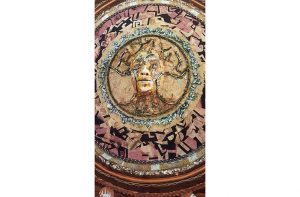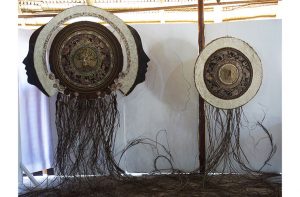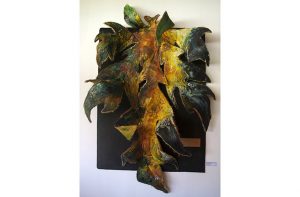By Dominique Hunter
WHETHER you choose to call it luck or fate or divine intervention, one thing is certain: Kamalita Heralall’s story is a remarkable account of an undeniable talent that blossomed in spite of the threats presented by less than ideal circumstances. Hers is a story filled with many twists and turns but, more importantly, a core group of supportive individuals, all of whom would’ve recognised the untapped potential of a young woman long before she recognised it herself.

The former Charlestown Secondary School student was incredibly transparent about the difficult journey that led to a rather unexpected start as a creative practitioner. She explained that she had dropped out of school as a second form student and was home for about two years. Immediately after this period of inactivity, she decided that it was time for a change and took it upon herself to enter various youth groups as a way of rekindling the drive she seemed to have lost during those years. It was then that she discovered the Carnegie School of Home Economics and ultimately shifted the trajectory of her life.
“They sent me to the Craft Production and Design Division that was located in the compound. After that I graduated with two distinctions, one in visual art and another in garment construction,” she stated.

Having successfully completed the programme, Heralall explained that she was urged to enroll at the E.R. Burrowes School of Art by Michelle Damon, someone who would remain a constant source of encouragement along her creative journey in the upcoming years. She admitted that although pursuing art, it was not an option that she had ever considered, since she never thought herself to be an artistic person but, she heeded the advice of her mentor.
“It was her continued belief in me and my ability that contributed significantly to me gaining my distinction in visual art and garment construction. She was the person who was pushing me all along to get where I am today,” she explained.
Speaking on her experience at the art school, Heralall said that her decision to enroll at the institution marked a significant shift in the course of her life. It was there that she “found” herself, as she described it.
She admitted that at the time of her enrolment at the art institution she had no knowledge of the technical aspects of most subjects offered by the school. In fact, after listening to her story some might even say that she caught a lucky break. On the day of her interview, the staff and students were busy making costumes and building floats for the annual Mashramani parade. As a result, she did not get a chance to sit the drawing exam, as is usually required of every applicant.
“If I had to draw before I got in there I don’t think I would’ve made it because I didn’t have any idea about drawing,” she said.
Initially, Heralall had enrolled in the certificate programme. However, upon completion, she was encouraged by the school’s administrator to pursue the diploma programme even though she did not have the CSEC requirements at the time. She quickly came to the realisation that the opportunity might not be available again any time in the near future and agreed to return, doing so under the condition that she maintained a certain grade and attendance record.
“If he [the school’s administrator] didn’t see my potential and push me to do it then I don’t think I would’ve gotten this far. I didn’t know I could do these things, and it amazes me to see how far I’ve come because I was just home doing nothing.”
Elaborating on the theme of her most recent body of work, which was on display at the Umana Yana back in September, she disclosed that her decision to use “Connecting with nature” as the conceptual framework was the result of wanting to see a more harmonious relationship between people and their respective environments.
“My work is more or less about awareness. It’s not just about me; it’s also about the public. The concept behind my major task was to create art that would encourage both [parties] to look at the simple aspects of nature that often go unnoticed,” she explained.

The repeated use of the tree motif in her work, which she describes as being a “carrier of knowledge and truth,” with specific references to the connectedness of its root system, is likened to the human body. Heralall insists that we must not allow the advancement of technology to overshadow the organic ways we initially used to commune with nature and each other. Instead, she describes the two as working in a complementary manner rather than existing as mutually exclusive entities. Ultimately, she says, it is our duty as conscious beings to ensure the sustainability of our environment, even as we continue to make advancements in technology.
She went on to describe, in great detail, her preference for working with simple elements like wood chips, and the dust produced from skiving and sanding leather, and other things that people tend to discard as having little to no value to the finished piece. By utilising those overlooked and unconventional types of material in her work, she is hopeful that it would encourage persons to be more cognisant of their environment and the endless creative possibilities of working with organic materials.
“I was exposed to patchwork in my textile class and I’ve branched off into so many areas since then. Patchwork allowed me to freely create a new type of base coverage because of the materials I work with. It allowed me to create something from it because I can place anything anywhere in order to cover a surface,” she explained.
Heralall noted that, in her experience, working with natural materials and fibres would present quite a few challenges on occasions, since some materials are flexible and others are not. But after carefully studying and testing the unique characteristics of each material, she is usually able to find ways of working around any limitations that might pop up, in order to produce a cohesive and aesthetically pleasing final piece.
When asked about any words of wisdom she might have for art school hopefuls who might be considering pursuing a formal education in the field, Heralall emphasised the importance of being exposed to as many creative disciplines as possible. This, she explained, would be crucial in the moulding of any talent and, more importantly, inspire new possibilities for making interesting works of art.
“Go and expose yourself to everything because there’s a lot that the school offers. See which one you want to do and don’t let anyone change your mind. Be yourself, stand your ground and do what you want to do. Don’t allow anyone to break your spirit,” she insisted.
Recognising that she might not be as fortunate to receive a similar opportunity to pursue her studies without having the relevant academic qualifications, Heralall explained that she is hopeful about writing a few CSEC subjects sometime in the near future. In addition to writing those subjects, she is also hopeful about introducing several crash courses of her own in textile design and construction for persons who might be interested in working under her guidance.



.jpg)









